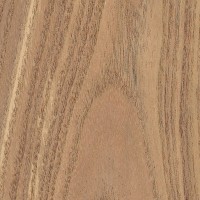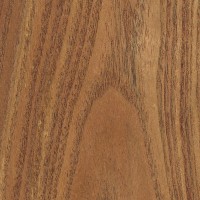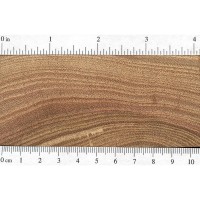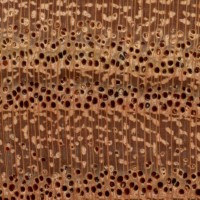 |
Common Name(s): Chinaberry Scientific Name: Melia azedarach Distribution: Southern Asia, Australia and Oceania Tree Size: 30-50 ft (9-15 m) tall, 1-2 ft (.3-.6 m) trunk diameter Average Dried Weight: 38 lbs/ft3 (610 kg/m3) Specific Gravity (Basic, 12% MC): .47, .61 Janka Hardness: 990 lbf (4,400 N) Modulus of Rupture: 14,100 lbf/in2 (97.2 MPa) Elastic Modulus: 1,300,000 lbf/in2 (8.97 MPa) Crushing Strength: 8,100 lbf/in2 (55.9 MPa) Shrinkage: Radial: 5.0%, Tangential: 8.5%, Volumetric: 13.6%, T/R Ratio: 1.7 |
Color/Appearance: Color can range from a light pinkish orange to a deeper reddish brown. Color becomes darker upon prolonged exposure to light. Well-defined sapwood is a lighter yellow.
Grain/Texture: Grain is usually straight, though occasionally interlocked. Texture is coarse and uneven, though with a pronounced natural luster.
Endgrain: Ring-porous (or sometimes semi-ring-porous); 2-4 rows of large earlywood pores, small to medium latewood pores in tangential, diagonal, or clustered arrangement; reddish brown heartwood deposits present in earlywood; rays may be just barely visible without lens; parenchyma vasicentric, confluent, and banded (marginal).
Rot Resistance: There are many conflicting reports on Chinaberry’s durability. The heartwood is generally considered at least moderately durable, and somewhat resistant to insect attack.
Workability: Due to it’s moderate density and generally straight grain, Chinaberry is quite easy to work: it cuts, planes, sands, and glues well. Perhaps the only difficulty is in its large pores, which tend to give a very open and grainy finished appearance, which may need to be filled, particularly if a smooth glossy surface is desired. (Though if left as-is, it serves well in applications where a rustic look is desired.)
Odor: No characteristic odor.
Allergies/Toxicity: Although severe reactions are quite uncommon, Chinaberry has been reported to cause skin and respiratory irritation, as well as headaches. See the articles Wood Allergies and Toxicity and Wood Dust Safety for more information.
Pricing/Availability: Not commercially available as lumber, Chinaberry is mostly restricted to smaller-scale and hobbyist uses. Most pieces available in the United States are not imported, but are harvested from (introduced) locally grown trees. Prices should be moderate for such a specialty species.
Sustainability: This wood species is not listed in the CITES Appendices or on the IUCN Red List of Threatened Species.
Common Uses: Veneer, carvings, furniture, and turned objects.
Comments: Sometimes called “Persian Lilac,” though the name usually rather refers to a hybrid lilac in the Syringa genus. Chinaberry is not closely related to true lilacs, but is rather related to the various types of Mahogany in the Meliaceae family.
Chinaberry is a potentially commercially valuable timber tree throughout its natural range in Asia, though perhaps under-utilized and under-appreciated. Chinaberry has also been introduced in the southeastern United States as an ornamental tree, though it’s now considered by many to be an invasive species.
None available.
Scans/Pictures: A special thanks to Mike Leigher for providing the wood sample of this wood species.








China berry is an invasive tree with an aggressive root system that kills native trees and shrubs. Cutting a China berry down or back to use as lumber is a public service. It’s impossible to kill, but cutting can control it and it is a very sustainable lumber source.
Half of the chinaberry I got for free. It’s spalted and has a beautiful blue color to the darker parts.
Does not bend well!! Very susceptible to splitting along the grain
Are branches off the tree of any use. The tree was cut down and the new shoots look like cane poles. Beautiful red.
I made some coasters from a branch. Very durable coasters.
I would say yes. They need to dry out, inside away from elements, a year for every inch of circumference.
Is chinaberry wood is good for door ?
Yes, it’s moderately durable
This tree has very pretty, small, pale purple flowers, which produce a very strong scent, able to induce asthma in susceptible people. The tree has quite a twisted form, so the grain is likely to be interesting.
This is a coffee table I made and entered in our state fair, made of old growth Chinaberry. The color is wild and I absolutely love it. Apparently the judges did too. I won best in show. ?? With that being said, I do not agree that it’s easy to work with. You have to do so much work to make it even, to sand the pores and build a shine. Plus they naturally rot from the inside out, so you have to stabilize that too. However, I feel that it’s worth it and a highly underrated wood.
Not sure why the image didn’t attach to your comment, but I believe this file is what you were trying to share:
I saw that when we cut down a 22m tall one.
I have a handcarved chinaberry rocking chair that is over 140 yrs old made by one of my great (?) uncles. It’s definitely a keepsake to me. I just moved and it’s in my storage at the moment.
Chinaberry makes a very beautiful acoustic guitar, and acoustically very similar to mahogany instruments.
I bought a chinaberry plank which was harvested and milled from a ranch in Weir TX,, roughly 12” wide, over 4/4 and about eight feet long. Thought it was going to sand with open pours, but out of thickness sander it has a sheen and seems denser than listed. It’s actually beautiful with darkened grain and light fibers but a medium blending which looks and feels denser than I predetermined. I’m thinking I’m going to go back and clear that mill out. Perfect for these bass guitar bodies
Chinaberry is an invasive species I have only known for the tree, the fruit is a giveaway as it looks like ceramic balls ~1/2 inch Diameter. Like Norfork Island pine, it is susceptible to breaking in a hurricane as thus a hazard near houses or other structures.
Very susceptible to breaking when climbed by 8 year olds.
Fortunately my dad was buying hay at the time.
Mr Robert Danforth I live in South Texas and am currently in for lack of a better word a war with these trees. Even the smaller ones or at least with a smaller circumference have a root system that nightmares are made of. If you had any knowledge on how to eliminate them permanently without having to dig for months? I’m just tired and I haven’t even begun to make a dent in the dozen or so trees on my property they’ve destroyed my driveway my plumbing my Home itself the foundation is completely destroyed All due to this tree.… Read more »
This tree grows for miles in Central Florida along old railroad tracks. The bark peels off like a banana. Very easy to work with.
Wonder why it’s associated with the tracks?
Yeah, that’s interesting because a friend of mine has one behind his house not 40 feet from the railroad tracks.
My Mother has one in her field that is over 50 years old.
Chinaberry seat in concrete
I just bought a carving of Chinaberry and want to put it in an outdoor setting. What do I need to do to protect/seal it? Your bench is beautiful.
What stain and finish did you use? It almost looks like a natural graft of two trunks. You did a great job.
I have a large bowl made from a China berry wood. The wood has been dried, sanded and treated with mineral oil once a month. The bowl I will be used to make biscuits. I’ve been told that the wood is still poisonous. Is this true?
The toxins in the wood from what I’ve read up are called limonoid tetranotriterpenes. Here is a reliable source of info on Melia toxicity -https://pubmed.ncbi.nlm.nih.gov/32197892/&ved=2ahUKEwi4hJzHvM6GAxV4VPEDHfikKXMQFnoECBUQAQ&usg=AOvVaw2F34LFY-6eN65LmPhPcg5D
From what I could gather, limonoids are mostly non-toxic to humans and are primarily found in the seeds of citrus and other plants in the Meliaceae family, as well as in roots and bark. I couldn’t find anything about the wood itself, though. The berries from the tree are toxic, as are probably the bark, leaves and flowers, but the wood itself should be fine. I’d be more concerned about the large pores, if anything.
I live in deep south Texas, Chinaberry is an unwanted invasive here We chop them down randomly as they pop up. After finding this nice grain pattern I may just mill my own and see what sort of things I can create! I will return and post photos if I go through with it!
go ahead and post some pics!
I am working with some Chinaberry right now and am finding it has an odor similar to a well stocked humidor.
Hi les, I’m curious how you identified that it is in fact Chinaberry. It should not have much of a scent when sanded or cut/planed. But if you are using a table saw, then perhaps.
Does the end grain look like this? How about the face grain?